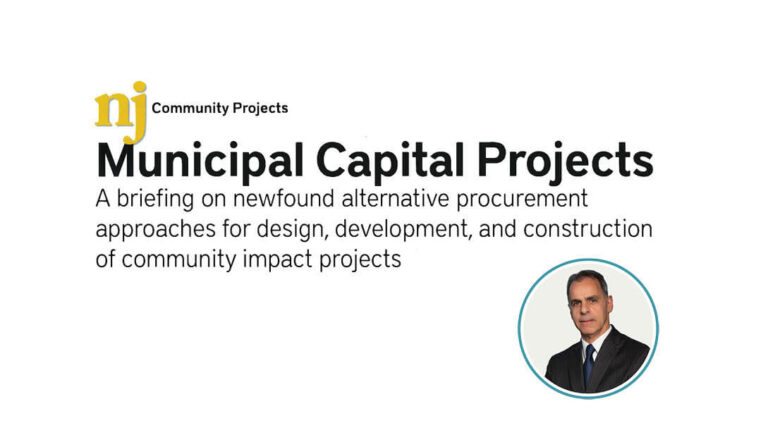Charles H. Sarlo, Esq. provides a briefing on newfound alternative procurement approaches for design, development, and construction of community impact projects.
“Change is the law of life. And those who look only to the past or present are certain to miss the future.” -John F. Kennedy
In 1976, Major League Baseball (MLB) accepted change via the introduction of free agency, some 75 years after the formation of the MLB organization, albeit being forced by a court ruling. Although the MLB teams were reluctant at first to embrace this change, today, the free agency period offers the opportunity for a team to put itself in the best possible position for success after consideration of all alternatives.
In a similar vein, some 50 years after the adoption of the Local Public Contracts Law (LPCL) in 1971, the New Jersey Legislature has, within the last few years, enacted new statutes to offer municipalities and other public entities alternate paths for design and construction procurement related to capital projects.
Each alternate public procurement method is unique and each offers certain benefits and drawbacks. No longer is a municipality restricted to the status quo of using the LPCL for the retention of contractors, but rather should consider the LPCL along with the alternative procurement methods to ascertain the best chance for the successful outcome of a capital project.
Local Public Contracts Law (LPCL)
The use of the LPCL will continue to be the standard bearer. The general familiarity of this procurement method, and given it has been “time tested,” currently makes this procurement approach the “go to” by default.
The LPCL is based on the submission of sealed bids by contractors, based on a complete design, and the award to the lowest responsible bidder.
There is a significant body of case law, which evidences that this “time tested” procurement method is not immune from litigation by unsuccessful bidders or improper project specifications or other legal issues.
Nevertheless, in certain situations, such as smaller, non-complex capital projects like facility upgrades or additions, the LPCL will continue to be the standard bearer.
Design-Build Law
Most recently, in 2021, the Design-Build Construction Services Procurement Act (P.L . 2021, c.71 (A-1285)) was signed into law. This design-build procurement allows a public entity to place an emphasis on design and quality, along with cost, the latter being only one factor in the selection process, which must comprise of at least 50% of the scoring criteria.
This procurement process allows the public entity to deal with a single source throughout the duration of the project, rather than coordinating between various parties. The approach is intended to provide cost savings and a streamlined public project delivery to the contracting unit.
For municipalities, capital projects must exceed $5 million for this procurement process. Increasingly, this procurement method is being used for new buildings in the range of 20,000 sq. ft. and greater.
Public-Private-Partnership Law (P3)
The pinnacle of public procurement is the use of the Public-Private-Partnership (P3) Law, P.L. 2018, c.90 (S-865), which came into the public procurement mix in 2018. Although the statute and its enabling regulations are somewhat complex, the P3 Law allows public entities to enter into an agreement with a private entity, whom assumes the financial and administrative responsibility for the design, development, and construction (which alternatively may be reconstruction, repair, alteration, or improvement in whole or in-part) and, over a 30-year period, the maintenance of the public facility.
By way of limited example, over the course of the 30-year period, if an elevator or HVAC system requires maintenance or replacement, the responsibility remains with the P3 developer and not the public entity. The P3 project can be financed in whole, or in part, by the private entity. Financing considerations include a “hand back plan” of the facility to the public entity after 30 years. The P3 agreement establishes the public entity’s expectation of the condition of the facility upon turnover by the P3 developer after 30 years (i.e., at year 30, does the public entity want brand new HVAC equipment or equipment with a certain percentage of life expectancy?).
Redevelopment Law (LRHL)
Lastly, somewhat fitting in between the Design-Build and P3 approaches, is the use of the Local Redevelopment and Housing Law (N.J.S.A. 40A:12A-1, et seq.) (LRHL). This was adopted in 1992, but only in the last several y ears has been increasingly used for the procurement of design, development and/or construction of public capital projects.
Recent court opinions may have injected some uncertainty into the use of the Redevelopment Law for public project procurement, however, depending on the structure of the transaction, the use of the Redevelopment Law remains a viable consideration for municipal entities, e.g., Dobco, Inc. v. Bergen County lmprovement Authority (2022).
The use of the Redevelopment Law by the BCIA was challenged on the basis that contractor election had to be via the LPCL.
The NJ Supreme Court stated that compliance with the Local Public Contract Law was required “in the setting of this appeal.” The Appellate Division had concluded that under these particular facts: “The prudent usage of taxpayer dollars remains paramount in undertaking capital public projects, which creates a compelling argument for municipal officials and their administration to assess the various capital project procurement options now available.”
Close Up on P3
The P3 Law is, in essence, a turn-key approach undertaken by the private sector and an alternate financing mechanism. Use of the P3 Law is best for complex projects as it shifts the risk from the public sector to the private sector, which is generally more attuned to business risk.
The P3 Law has many benefits, including allowing alternate, upfront financing, private sector creativity and full deployment of its expertise, and reduction of public entity human capacity to manage and oversee a development and construction project.
For municipalities, capital projects must exceed $10 million to avail itself to this procurement process. To date, there have been no P3 project applications submitted to the Department of Treasury Office of Public Finance (OPF) for approval, as required by the statute, although one municipality has gone through the regulatory procurement process for a P3 developer and design/ construction team and is readying for the submission of an application to the OPF for a new municipal complex and recreation facility.
Accepting new options
Back in 1976, MLB teams recognized the necessity of participating in the newfound change to the industry known as free agency, except the then-world champion Cincinnati Reds, who chose the status quo approach. Thereafter, the assessment of free agents quickly became a common practice and an alternative approach to the draft for MLB organizations in their quest to give their teams the best opportunity for success.
Like free agency, which was derived out of the legal process, public entities now have been given the statutory tools for the assessment of alternate procurement for the design, development and/or construction of capital projects.
“The first step toward change is awareness. The second step is acceptance.” -Nathaniel Branden
This article originally appeared in NJ Municipalities magazine.





